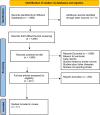Chronic high-altitude exposure and the epidemiology of ischaemic stroke: a systematic review
- PMID: 35487749
- PMCID: PMC9058702
- DOI: 10.1136/bmjopen-2021-051777
Chronic high-altitude exposure and the epidemiology of ischaemic stroke: a systematic review
Abstract
Introduction: About 5.7% of the world population resides above 1500 m. It has been hypothesised that acute exposure to high-altitude locations can increase stroke risk, while chronic hypoxia can reduce stroke-related mortality.
Objective: This review aims to provide an overview of the available evidence on the association between long-term high-altitude exposure and ischaemic stroke.
Design: A systematic review was performed from 1 January 1960 to 1 December 2021 to assess the possible link between high-altitude exposure and ischaemic stroke. The AMED, EMBASE, Cochrane Library, PubMed, MEDLINE, the Europe PubMed Central and the Latin-American bibliographic database Scielo were accessed using the University of Southampton library tool Delphis. In this review, we included population and individual-based observational studies, including cross-sectional and longitudinal studies except for those merely descriptive individual-based case reports. Studies were limited to humans living or visiting high-altitude locations for at least 28 days as a cut-off point for chronic exposure.
Results: We reviewed a total of 1890 abstracts retrieved during the first step of the literature review process. The authors acquired in full text as potentially relevant 204 studies. Only 17 documents met the inclusion criteria and were finally included. Ten studies clearly suggest that living at high altitudes may be associated with an increased risk of stroke; however, five studies suggest that altitude may act as a protective factor for the development of stroke, while two studies report ambiguous results.
Conclusions: This review suggests that the most robust studies are more likely to find that prolonged living at higher altitudes reduces the risk of developing stroke or dying from it. Increased irrigation due to angiogenesis and increased vascular perfusion might be the reason behind improved survival profiles among those living within this altitude range. In contrast, residing above 3500 m seems to be associated with an apparent increased risk of developing stroke, probably linked to the presence of polycythaemia and other associated factors such as increased blood viscosity.
Keywords: angiogenesis; high altitude; hypoxia; review; stroke; thrombosis.
© Author(s) (or their employer(s)) 2022. Re-use permitted under CC BY-NC. No commercial re-use. See rights and permissions. Published by BMJ.
Conflict of interest statement
Competing interests: None declared.
Figures


Similar articles
-
Beyond the black stump: rapid reviews of health research issues affecting regional, rural and remote Australia.Med J Aust. 2020 Dec;213 Suppl 11:S3-S32.e1. doi: 10.5694/mja2.50881. Med J Aust. 2020. PMID: 33314144
-
Prevalence and risk factors of stroke in high-altitude areas: a systematic review and meta-analysis.BMJ Open. 2023 Sep 21;13(9):e071433. doi: 10.1136/bmjopen-2022-071433. BMJ Open. 2023. PMID: 37734891 Free PMC article.
-
The effect of exposure to long working hours on stroke: A systematic review and meta-analysis from the WHO/ILO Joint Estimates of the Work-related Burden of Disease and Injury.Environ Int. 2020 Sep;142:105746. doi: 10.1016/j.envint.2020.105746. Epub 2020 Jun 3. Environ Int. 2020. PMID: 32505015
-
Stroke at Moderate and High Altitude.High Alt Med Biol. 2022 Mar;23(1):1-7. doi: 10.1089/ham.2021.0043. Epub 2021 Oct 11. High Alt Med Biol. 2022. PMID: 34637624 Review.
-
Stroke-Related Mortality at Different Altitudes: A 17-Year Nationwide Population-Based Analysis From Ecuador.Front Physiol. 2021 Sep 30;12:733928. doi: 10.3389/fphys.2021.733928. eCollection 2021. Front Physiol. 2021. PMID: 34675818 Free PMC article.
Cited by
-
Prevalence of stroke and associated risk factors: a population-based cross-sectional study from the Qinghai-Tibet Plateau of China.BMJ Open. 2022 Nov 22;12(11):e065605. doi: 10.1136/bmjopen-2022-065605. BMJ Open. 2022. PMID: 36414281 Free PMC article.
-
The onset of cerebral infarction may be affected by differences in atmospheric pressure distribution patterns.Front Neurol. 2023 Jul 31;14:1230574. doi: 10.3389/fneur.2023.1230574. eCollection 2023. Front Neurol. 2023. PMID: 37583952 Free PMC article.
-
The association between altitude and cerebral small vessel disease burden in the Tibetan population: a cross-sectional study.Sci Rep. 2025 Jul 5;15(1):24035. doi: 10.1038/s41598-025-09891-2. Sci Rep. 2025. PMID: 40617883 Free PMC article.
-
Epidemiological characterization of ischemic heart disease at different altitudes: A nationwide population-based analysis from 2011 to 2021 in Ecuador.PLoS One. 2023 Dec 29;18(12):e0295586. doi: 10.1371/journal.pone.0295586. eCollection 2023. PLoS One. 2023. PMID: 38157383 Free PMC article.
-
Cerebral small-vessel disease at high altitude: A comparison of patients from plateau and plain.Front Neurol. 2023 Mar 9;14:1086476. doi: 10.3389/fneur.2023.1086476. eCollection 2023. Front Neurol. 2023. PMID: 36970535 Free PMC article.
References
Publication types
MeSH terms
LinkOut - more resources
Full Text Sources
Medical
Miscellaneous
